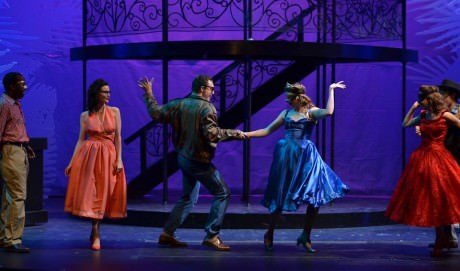
In Part One of a series of interviews with the cast, director, and designers of Annapolis Shakespeare Company’s Much Ado About Nothing, Choreographer Ken Skrzesz talks about working with Director Sally Boyett-D’angelo and his dancers to create the choreography for the production.
Joel: How did you get involved in this production at Annapolis Shakespeare Company?
Ken: Sally contacted me after she landed on the time period if the piece. 1958 allows for some great dancing and we quickly clicked as we discussed our ideas.
Where did you receive your training?
I’ve danced since the age of 12 starting, oddly enough, with folk and social dancing. I moved into ballet at the Edna Lee Dance Studio i n Linthicum (a million years ago), and intensively trained in the BFA program at Towson University and the MFA program at UNC-Greensboro.
You have created choreography for several musicals. Have you created choreography for Shakespearean productions before and any other productions of Much Ado? Was it more difficult to create the choreography for Much Ado… than for the musicals an operas you had worked on before, and/or were their specific and new challenges here?
About 12 years ago I did the movement work for Maryland Stage Company’s production of Midsummer at CENTERSTAGE in Baltimore. The movement in that production, based in fantasy, was less character-driven.
The great thing about working on the movement for this production is that it is period specific and can help to drive the storytelling, which is my favorite way to work.
How would you describe your choreography for Much Ado?
I think I would say it is theatricalized social dances of the 1950’s.
Pick two scenes that were the most challenging for you and tell us about the choreography you selected and created for the scenes, and how the choreography helps to enhance or tell the story in those scenes.
Each scene presented the same challenge: how can the movement grow organically out of the scene? I think the actors quickly found a level of comfort with the movement that allows it to look like it comes as a natural expression of the moment.
Take us into the meetings you had with Sally and the other designers when you were all creating the design of the show. How often did you meet and what were some of the suggestions that the other designers gave you that you considered and incorporated into your final choreography?
Sally and I met several times during which she shared her vision, the set design, and the silhouette of the costumes all of which clarified movement choices. It’s always fun to creatively respond to vision and design.
How has Sally’s vision been translated to the stage by your work?
Sally was very specific about wanting the dance to begin as character interaction then grow into the energy of a full-on production number, shifting the focus from character-to-character to character-to-audience.
Are there good dancers in the cast? Which dance or choreography did the cast have the hardest time learning? Which dance or choreography was the easiest for them to learn?
Each actor quickly embraced the social dances of the period. Once they understood the basic styles, they seemed to have a great time as the styles evolved into choreography. There was pretty consistent joy in the whole process.
What does Much Ado… have to say to audiences in 2013?
It reminds us that behaving honorably matters.
What other Shakespearean productions would you like to create the choreography for and why?
I can find movement in any script. I’m always up for a challenge!

What do you want audiences to say about your choreography when they leave after seeing Much Ado About Nothing?
That it helped them understand the storytelling in a deeper way.
What’s next for you after Much Ado About Nothing?
I’ve been commissioned for a new concert dance piece by Kinetics Dance Theatre in Ellicott City and I’ll continue my work with the Performing and Visual Arts Magnet Programs with Anne Arundel County Public Schools.
LINK
Amanda Gunther’s review of Much Ado About Nothing.
Much Ado About Nothing plays through August 18, 2013 at Annapolis Shakespeare Company performing at The Bowie Playhouse — 16500 White Marsh Park Drive, in Bowie, MD. For tickets, call the box office at (410) 415-3513, or purchase them online.





